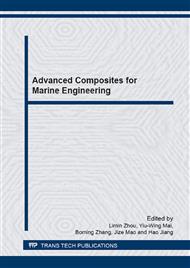[1]
Can W, Hao-ran C, Zhen-kun L. Experimental investigation of interfacial fracture behavior in foam core sandwich beams with visco-elastic adhesive interface, Compos Struct. 92(2010) 1085-1091.
DOI: 10.1016/j.compstruct.2009.10.011
Google Scholar
[2]
Sridharan S, Displacement-based mode separation of strain energy release rates for interfacial cracks in bi-material media, Int J Solids Struct. 38(2001) 6787–6803.
DOI: 10.1016/s0020-7683(01)00050-6
Google Scholar
[3]
El-Sayed S, Sridharan, S. Cohesive layer models for predicting delamination growth and crack kinking in sandwich structures. Int J Fract. 117(2002) 63-84.
Google Scholar
[4]
Prasad S, Carlsson LA. Debonding and crack kinking in foam core sandwich beam-II, experimental investigation. Eng Fract Mech. 47(1994) 825-41.
DOI: 10.1016/0013-7944(94)90062-0
Google Scholar
[5]
Li X, Carlsson LA. The tilted sandwich debond (TSD) specimen for face/core interface fracture characterization. J Sandwich Struct Mater. 1(1999) 60-75.
DOI: 10.1177/109963629900100104
Google Scholar
[6]
Sridharan S, Yupeng L. Static and dynamic delamination of foam core sandwich members. AIAA Journal. 44(2006) 2937-2948.
DOI: 10.2514/1.20525
Google Scholar
[7]
Berggreen C, Simonsen BC. Experimental and numerical study of interface crack propagation in foam-cored sandwich beams. J Compos Mater. 41(2007) 493-520.
DOI: 10.1177/0021998306065285
Google Scholar
[8]
MC Saha, E Kabir, S Jeelani. Study of debond fracture toughness of sandwich composites with nanophased core. Mater Lett. 62(2008) 567-570.
DOI: 10.1016/j.matlet.2007.06.017
Google Scholar
[9]
Peters WH, Ranson WF. Digital imaging techniques in experimental stress analysis. Opt Eng. 21(1982) 427-432.
Google Scholar
[10]
Sutton MA, Wolters WJ, Peters WH, Ranson WF, McNeill SR. Determination of displacements using an improved digital image correlation method. Image Vis Comput. 1(1983) 133-139.
DOI: 10.1016/0262-8856(83)90064-1
Google Scholar
[11]
Sutton MA, Deng X, Ma F, Newman Jr JC, James M. Development and application of a crack tip opening displacement-based mixed mode fracture criterion. Int J Solids Struct. 37(2000) 3591-3618.
DOI: 10.1016/s0020-7683(99)00055-4
Google Scholar
[12]
ASTM D5528-01, Standard test method for mode I interlaminar fracture toughness of unidirectional fiber-reinforced polymer matrix composites, (2007).
DOI: 10.1520/d5528-01r07e01
Google Scholar
[13]
Suo Z. Singularities, interfaces and cracks in dissimilar anisotropic media. Proc Roy Soe London. 1990, pp.331-358.
Google Scholar


